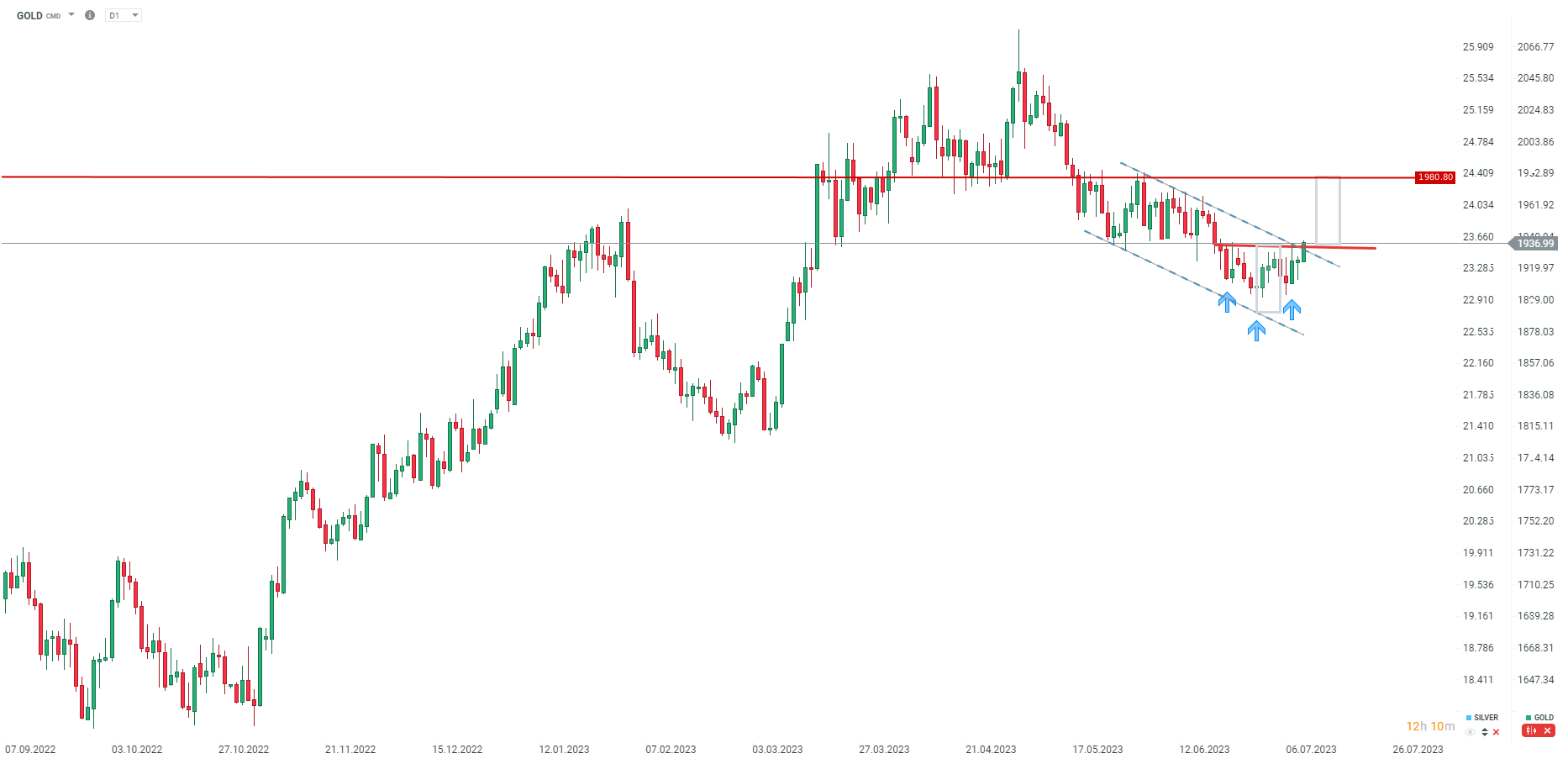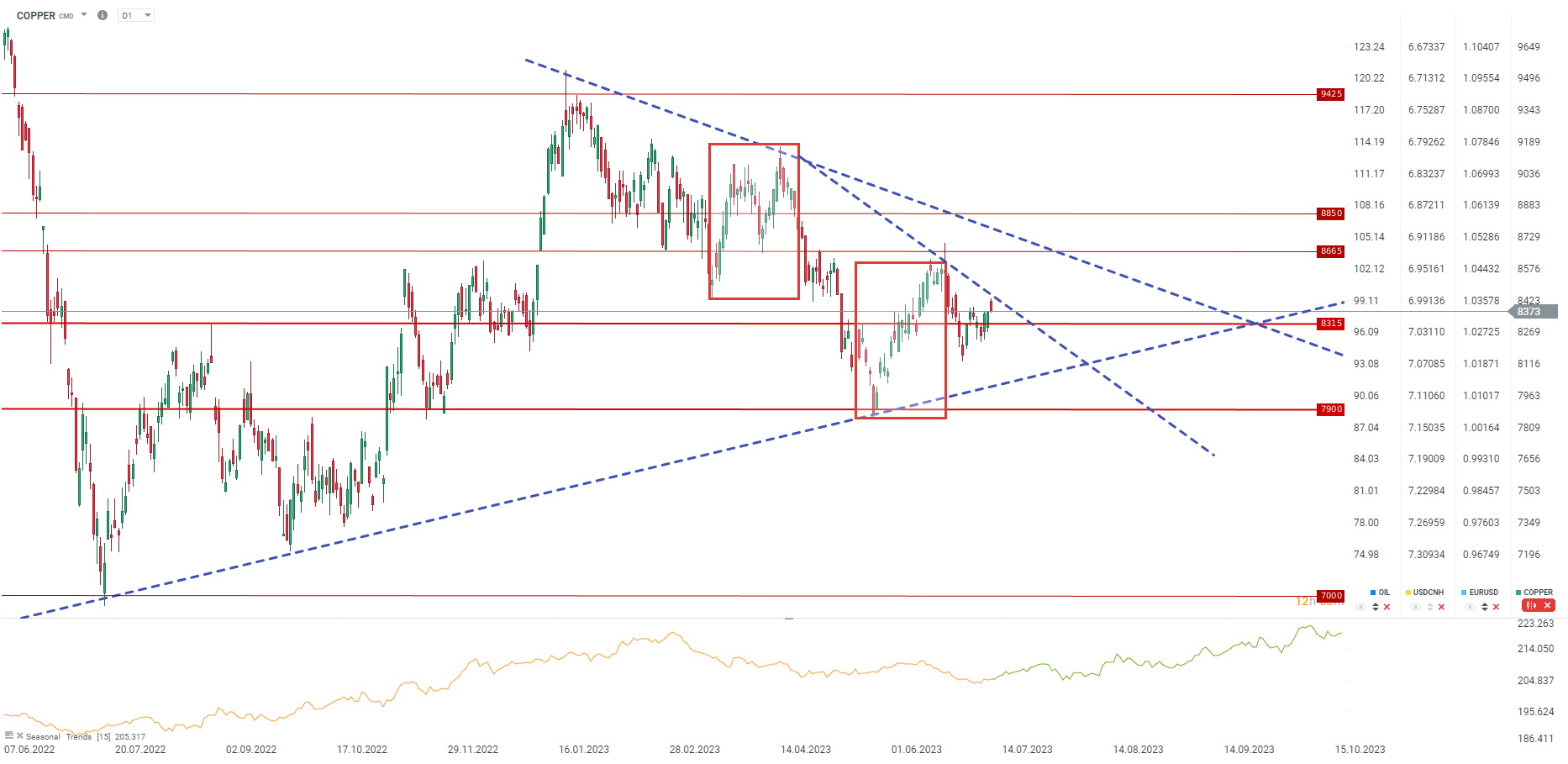Oil:
- Oil is reacting with an increase to the news about support for the real estate market in China, which could potentially revive economic growth in that country in the second half of the year. The support for the real estate market is to be extended until the end of 2024.
- From a 30-day calendar perspective, oil has already rebounded over 8%, reducing its annual losses to just -9%. The second half of the year may neutralize these losses.
- It is expected that additional cuts by Saudi Arabia and Russia from August may lead to the formation of higher price consolidation in Brent oil in the range of 80-85 USD per barrel.
- The International Energy Agency (IEA) expects a revival of demand in emerging countries, especially in China, to be strong. Additionally, the IEA sees a deficit in the oil market in the second half of the year.
- On the other hand, JP Morgan expects further supply cuts (700kbd) from OPEC+, which are to balance the increase in supply in countries outside the cartel. JP Morgan expects the extension of the OPEC+ production cut target to 2024.
- Positioning on Brent is moderately rebounding on the Intercontinental Exchange (ICE), but a clear rebound in net positioning on the New York Mercantile Exchange (NYMEX) is also visible.
- Comparative inventories are starting to decline significantly, which gives a positive signal for oil. A reduction in exports from Saudi Arabia may also affect the reduction in US inventories.
- The forward curve no longer shows a short contango over a 3-month perspective, as it was a few weeks ago, which means that demand has started to rebound in the short term.
Comparative inventories of oil have started to decline noticeably, which is a positive signal for oil. Of course, the scenario from the September-December period may repeat itself when comparative inventories fell to a negative level only momentarily. However, if inventories fall to a negative level this time, it could indicate real tension in the oil market in the US as well. Source: Bloomberg.

Brent oil is preparing to break out of the consolidation, which is limited from above by the level of 78.5 USD. The breakout would give the first potential target at the level of 85 USD per barrel. On the other hand, seasonality indicates minor declines until the end of July. Source: xStation5
Gold:
- Just like other commodities, gold is receiving support in the form of a promise of a larger stimulus package in China, which may increase the amount of money in the market.
- Greater support from China will offset the negative impact of liquidity withdrawal by the Federal Reserve or the European Central Bank.
- Gold is approaching a very important technical point during a significant period of the year related to seasonality.
- Technically, we can observe an attempt to break through the neckline of the Reverse Head and Shoulders pattern with the formation's range to 1970/1980 USD per ounce.
- 5-year and long-term seasonality indicate that we are approaching a local bottom.
- Voices have appeared in the Fed suggesting that some members want a longer waiting period before the next possible increase. A lot may depend on the CPI inflation publication on Wednesday, July 12. The next Fed meeting is not until July 27.
- Yields in the US are starting to slightly reverse strong increases, the 2y10y spread has clearly started to rebound - similar to March of this year. Then, gold rebounded from around 1800 USD to around 2050 USD per ounce.
- The spread was already -110 basis points, and now it is "only" -87 basis points.
Seasonality on gold shows that the second half of the year should be much better than the last two months. On the other hand, on the monthly chart, a potential triple top formation is still visible. Source: Bloomberg, XTB.
The 10y2y spread is starting to rise again, which could be an important signal for gold, similar to what it was in March. Source: Bloomberg, XTB.

A potential Reverse Head and Shoulders pattern has appeared on gold on D1 with a neckline test at 1935 USD with a target at 1980. Additionally, we observe a potential breakout from the declining trend channel. Source: xStation5.
Wheat:
- The quality of wheat crops in the USA remains at a relatively low level. Only 40% of winter wheat is in good or excellent condition.
- The quality of spring wheat crops is slightly declining. 47% of crops are in good or excellent condition, compared to the previous 48%.
- At the same time, the winter wheat harvest season in the US is the slowest in 20 years, which may indicate a high probability of lower yields.
- At this moment, 46% of the sown area has been harvested, while the 20-year average is 77%. Such slow yields were last seen 62 years ago.
- High temperatures are occurring in the United States, which are destroying crops, especially due to insufficient rainfall.
- On Wednesday, July 12, the WASDE report will appear, which is theoretically supposed to show larger wheat stocks and production. There is, therefore, plenty of room for disappointment. Significantly lower final soybean stocks and slightly lower corn stocks are also expected.
- Additionally, the deadline for the expiration of the agreement on the export of agricultural commodities from Ukraine is approaching, which again provides uncertainty in the market. The agreement was initially concluded on July 22, 2022. It was last renewed on May 18 for 60 days.
Wheat is the second most frequently transported agricultural commodity from Ukraine by ships in the Black Sea. Wheat is a key agricultural commodity for emerging countries. Source: S&P Platts.
The harvest of spring wheat in the US is proceeding at the slowest pace in several decades. Source: Bloomberg, XTB.
Forecasts for the WASDE report, which will appear on July 12. As you can see, expectations for wheat are rather negative for prices, so there is potential for surprise. Source: Bloomberg.
Positioning on wheat has undergone a significant change - a significant reduction in short positions is visible, which gives potential for a rebound in the second half of the year in the case of worse harvests than expected. Source: Bloomberg, XTB.
Copper:
- Copper has been rising since the beginning of this week. From the perspective of the beginning of this year, the loss does not seem large, but it is worth mentioning the copper rally at the beginning of this year in anticipation of strong economic recovery after the end of Covid-related restrictions.
- The recovery did not meet market expectations, the credit momentum was not too large, which leaves copper in consolidation in the form of a triangle formation.
- At the same time, data on loans in China for June show a clear rebound (new loans 3050 billion yuan compared to the expected 2318 billion yuan).
- On the other hand, there is talk of a significant upcoming demand from green energy manufacturers, and recent data on mining production in South America show over 10% production declines compared to levels last year.
- Positioning on copper is also improving.
The credit impulse in China does not look the best - it does not show a clear stimulation of the economy. On the other hand, data on new loans for June show a clear rebound, which could be a turning point for the entire credit impulse. Source: Bloomberg, XTB.
Positioning on copper shows an improvement, after a very strong sell-off in May. Source: Bloomberg, XTB.
 The price is potentially breaking out of the sequence of lower lows and peaks, though it is reacting to the downward trend line. A breakout could direct the price towards the level of 8665 USD per ton. Source: xStation5.
The price is potentially breaking out of the sequence of lower lows and peaks, though it is reacting to the downward trend line. A breakout could direct the price towards the level of 8665 USD per ton. Source: xStation5.
A kakaó árfolyama emelkedik az észak-amerikai őrlési adatok és az elefántcsontparti export lassulása miatt 📈
⏬ Az ezüst ára közel 5%-kal zuhant
Talpra Tréder - 2025.10.20.
Reggeli összefoglaló (20.10.2025)
Ezen tartalmat az XTB S.A. készítette, amelynek székhelye Varsóban található a következő címen, Prosta 67, 00-838 Varsó, Lengyelország (KRS szám: 0000217580), és a lengyel pénzügyi hatóság (KNF) felügyeli (sz. DDM-M-4021-57-1/2005). Ezen tartalom a 2014/65/EU irányelvének, ami az Európai Parlament és a Tanács 2014. május 15-i határozata a pénzügyi eszközök piacairól , 24. cikkének (3) bekezdése , valamint a 2002/92 / EK irányelv és a 2011/61 / EU irányelv (MiFID II) szerint marketingkommunikációnak minősül, továbbá nem minősül befektetési tanácsadásnak vagy befektetési kutatásnak. A marketingkommunikáció nem befektetési ajánlás vagy információ, amely befektetési stratégiát javasol a következő rendeleteknek megfelelően, Az Európai Parlament és a Tanács 596/2014 / EU rendelete (2014. április 16.) a piaci visszaélésekről (a piaci visszaélésekről szóló rendelet), valamint a 2003/6 / EK európai parlamenti és tanácsi irányelv és a 2003/124 / EK bizottsági irányelvek hatályon kívül helyezéséről / EK, 2003/125 / EK és 2004/72 / EK, valamint az (EU) 2016/958 bizottsági felhatalmazáson alapuló rendelet (2016. március 9.) az 596/2014 / EU európai parlamenti és tanácsi rendeletnek a szabályozási technikai szabályozás tekintetében történő kiegészítéséről a befektetési ajánlások vagy a befektetési stratégiát javasló vagy javasló egyéb információk objektív bemutatására, valamint az egyes érdekek vagy összeférhetetlenség utáni jelek nyilvánosságra hozatalának technikai szabályaira vonatkozó szabványok vagy egyéb tanácsadás, ideértve a befektetési tanácsadást is, az A pénzügyi eszközök kereskedelméről szóló, 2005. július 29-i törvény (azaz a 2019. évi Lap, módosított 875 tétel). Ezen marketingkommunikáció a legnagyobb gondossággal, tárgyilagossággal készült, bemutatja azokat a tényeket, amelyek a szerző számára a készítés időpontjában ismertek voltak , valamint mindenféle értékelési elemtől mentes. A marketingkommunikáció az Ügyfél igényeinek, az egyéni pénzügyi helyzetének figyelembevétele nélkül készül, és semmilyen módon nem terjeszt elő befektetési stratégiát. A marketingkommunikáció nem minősül semmilyen pénzügyi eszköz eladási, felajánlási, feliratkozási, vásárlási felhívásának, hirdetésének vagy promóciójának. Az XTB S.A. nem vállal felelősséget az Ügyfél ezen marketingkommunikációban foglalt információk alapján tett cselekedeteiért vagy mulasztásaiért, különösen a pénzügyi eszközök megszerzéséért vagy elidegenítéséért. Abban az esetben, ha a marketingkommunikáció bármilyen információt tartalmaz az abban megjelölt pénzügyi eszközökkel kapcsolatos eredményekről, azok nem jelentenek garanciát vagy előrejelzést a jövőbeli eredményekkel kapcsolatban.


